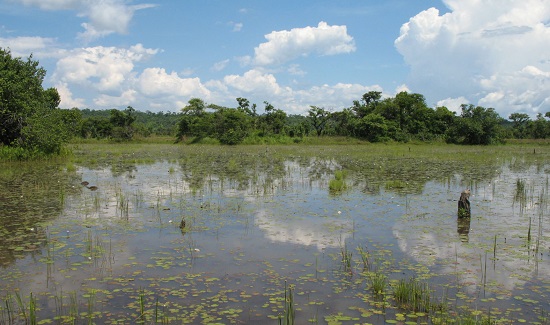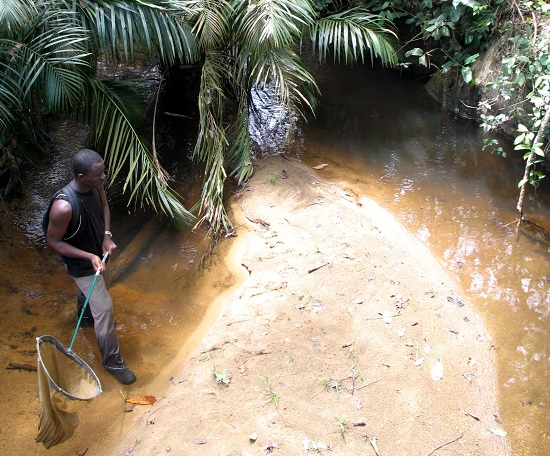Studying Odonata
Habitats
Odonates occur at all types of freshwater habitats. Generally habitats with a good water quality (e.g. clear), aquatic and bank-side vegetation (e.g. water lilies, rushes, weeds) and a natural morphology (e.g. not canalised or dammed) have more species. Sun is important: some species like to bask, others prefer the shade. Temporary or disturbed habitats such as rain puddles, rice fields and irrigation ditches usually harbour widespread, common species. More specialised species are found on small running waters in forest, and this is also where you may expect regional endemics. Such waters are usually largely shaded, have clear shallow water, and no aquatic vegetation. Also interesting are rivers, especially forested ones. Here there is more sun and vegetation, allowing a different spectrum of species. Small special habitats can contain specialised, rare species. Examples are seepages (where water oozes from the ground), the spray-zone of waterfalls, wet trickles along rock faces, rapids, phytotelmata (small pockets of water in plants, like tree holes) or small forest pools and swamps.

Katanga, Democratic Republic of the Congo. Photo K.-D.B. Dijkstra
Taking photographs is a good way to communicate about habitat types. Important factors in describing dragonfly habitats are:
(1) type, e.g. pool, lake, marsh, paddy, river, stream, waterfall, seepage;
(2) running or standing water, e.g. slow-moving, torrential;
(3) temporary or permanent water;
(4) size, i.e. diameter, depth;
(5) forest or vegetation cover, amount of sun and shade;
(6) turbidity of water, e.g. clear, blackwater, murky, silt-laden, chalky;
(7) hydrochemistry, e.g. acidity, dissolved oxygen, trophic status;
(8) presence and type of aquatic vegetation, e.g. green algae, lily pads, emergent plants, water hyacinth;
(9) presence and type of bank-side vegetation, e.g. reeds, bushes, grass;
(10) bottom substrate, e.g. mud, sand, gravel, rocks, detritus;
(11) human disturbance, e.g. clearance of vegetation, erosion, damming, altered course.

Wetland in Angola. Photo K.-D.B. Dijkstra
Finding and catching adults
It is necessary to spread your efforts through the day and through the terrain. Of course the best place to look is around freshwater, where males defend territories and look for females, which come to lay eggs. Adults can also be found away from water, e.g. roosting or feeding. Many species siccatate as adults, i.e. await the rainy season away from water. Adults often congregate in (or at the edges of) open areas, such as forest clearings, roadsides and grassy fields, to feed on insects. Some species (e.g. Gomphidae) are very shy at the breeding habitat and provide better opportunities for capture in their feeding grounds. Most species prefer warm (sunny) weather and are active during the day, with a maximum of activity at midday. Others are only active in twilight (dusk, dawn) and spend the day hiding in the vegetation. Species that perform high and fast patrol flights along streams during the day may be much easier to catch while feeding low down along forest roads and other open areas at dawn.
Generally a butterfly net is suitable (net opening about 0.5 m wide, handle at least 1 m long). The net must be deep enough to fold closed, so the catch cannot escape. For large Anisoptera a large, light net is useful. Such a big net can be hard to manoeuvre when catching Zygoptera in dense vegetation. A net with a handle of variable length is useful (e.g. telescopic or segmented). The easiest way to store live dragonflies is in small envelopes (like those used by philatelists for postage stamps) or folded paper triangles ('papillottes') in a plastic container. Put tandems in one envelope. Because the colours of adults fade or change after preservation it is valuable to take photographs of the adults, either free or in the hand.

Collecting adults. Photo K.-D.B. Dijkstra
Preserving adults
Drying with acetone gives the best preservation. Although it is both highly inflammable and toxic, its use in the field poses no problems if acetone is handled with care. Simply putting dead dragonflies out to dry is only successful in dry climates. In a moist climate they will become mouldy and the prolonged period of drying increases the risk of damage by vermin. Eventually the material becomes rather brown and smelly. Because acetone replaces the water in the animal's body, it dries very quickly, becoming stiff and sturdy, with relatively little colour loss and odour development. Acetone can be bought in chemical supply stores (for schools and laboratories) in most African capitals.
Dipping the individual in acetone kills it and makes it limp, making it easy to straighten the abdomen and stretch the legs. This is also the best time to extract the penis in damselflies, recommended especially in Elattoneura, Ceriagrion and the B-group of Pseudagrion. Its bow-like stem is always visible externally in the genital fossa. Carefully stick the tip of a fine pin under the stem and slide the penis up- and outwards (caudo-ventrally). Fold the wings above the body. Soak in acetone for at most 24 hours (about 12 is ideal). To avoid spreading of the wings, keep each individual in an envelope or between permeable paper.
Lay the specimens out to dry after soaking. A breeze or some sun helps, but specimens may blow away or be affected by overheating. Beware of potential consumers, especially ants! Depending on the conditions, about half an hour is sufficient for the acetone to evaporate (monitor the moisture oozing from the metastigma). Fresh (teneral) specimens are still soft and will crumple when dried and are therefore best stored in 70-95% alcohol; refresh a few times. For DNA samples remove a leg and store it in 95-100% alcohol.
Store the specimens in stamp envelopes or paper triangles in an airtight container. Add a little silica gel to keep dry and to extract additional moisture (this can also be used as the main drying agent if acetone is unavailable). Label each specimen clearly. Essential collection data are:
(1) name of collector/observer;
(2) locality name (at least country, region and name of nearby town);
(3) collection/observation date.
Other useful data are:
(4) map or GPS coordinates of the locality;
(5) habitat description;
(6) altitude;
(7) colours of living specimen.
Collecting larvae and exuviae
Although ADDO only provides information to identify adult dragonflies, many species are more easily found as larvae or exuviae (the larval skin left behind after emergence of the adult), particularly running water species, such as gomphids and macromiids. An important purpose of searching for larvae is rearing them to adult. Because odonatology has traditionally focused on adults, many interesting discoveries may be expected from rearing larvae.
A metal kitchen sieve or a sturdy net for amphibians is suitable to probe the microhabitats of larvae (weeds, silt, gravel, roots of riverside trees, patches of leaflitter, mud or sand). For both identification and rearing it is best to obtain full-grown larvae. These have well-developed wing-sheaths with clearly visible venation. Look for exuviae on banks, boulders or vegetation, from just above the water surface to a height of about 50 cm. Some larvae will, however, travel several metres from the water to emerge, becoming harder to find. Dragonflies prefer vertical substrates for emergence (e.g. plants, tree roots, steep banks, rock faces), but may also be found on horizontal substrates (floating plants, flat banks).
When you chase up a freshly emerged adult (which is still very pale, soft and shiny) from the waterside, try catching it and look for the exuviae. Exuviae are nothing more than dried skin, making them vulnerable and legs easily break off. By splashing some water on it, the exuviae becomes softer and less brittle. Notes about the larval habitat (among plants, buried in mud) or emergence site (place, height, substrate) are useful.

Collecting larvae. Photo K.-D.B. Dijkstra
Preserving larvae and exuviae
Store larvae in 70-95% alcohol; refresh a few times. Because larvae have a rather thick cuticula through which alcohol penetrates slowly, they may decay inside even when put in alcohol. To prevent this, prick the body one or a few times with a fine pin, preferably penetrating the gut. Exuviae must be stored dry in small containers that close tightly. Exuviae will often be moist after collecting, and may become mouldy in a closed container. Dry wet exuviae in the sun, or make a hole in the lid, so moisture can escape.
Rearing larvae
Place larvae in a tray, basin or aquarium with water and provide some substrate for them (e.g. sand, plants) and for emergence (e.g. a stick). Feed with small aquatic invertebrates (mosquito larvae, cladocerans, etc.). Transportation of larvae has three problems: drying, drowning and overheating. To make sure that the larva remains moist and oxygenated put it in moist cotton wool or toilet paper, with little or no free water and with plenty of air, in a small, closed container. Moss or other organic material can also be used, but may rot. Keeping the larvae in a cool-box at 5-10°C will extend their lifespan.

Photo K.-D.B. Dijkstra


